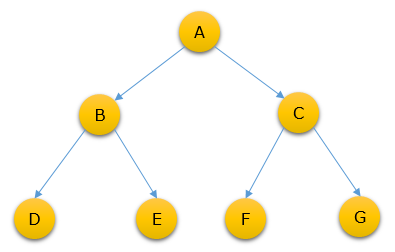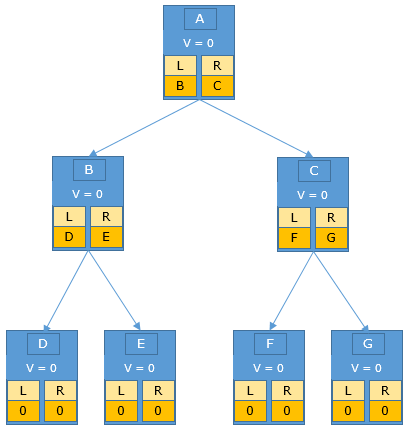|
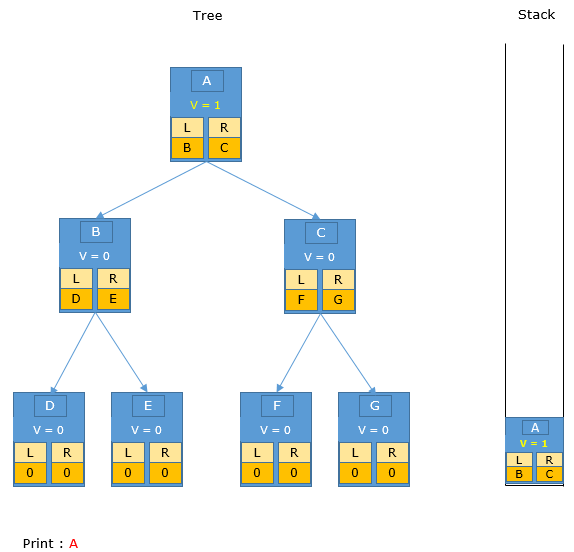
|
Get the root node.
Mark it as visited (v = 1)
Put it into stack
|
|
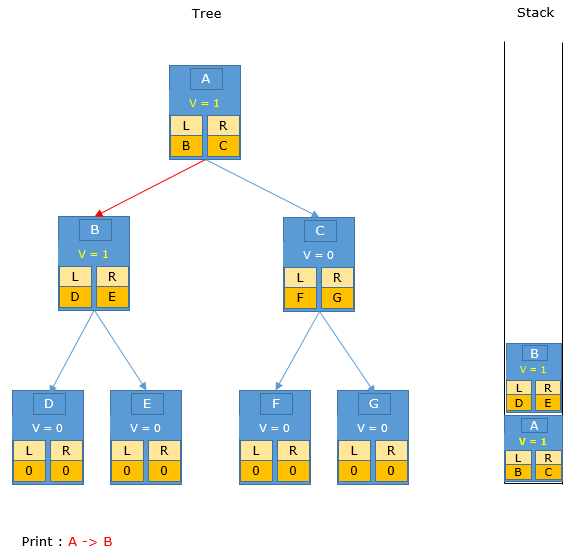
|
Get the item on the top of the stack shown in previous step (this is 'A' in this case).
Get the node on the left branch of 'A'. (it is 'B' in this case)
If it is unvisited(v = 0), mark it as visited (set v = 1), print it and put it into stack.
The result is as shown here.
|
|
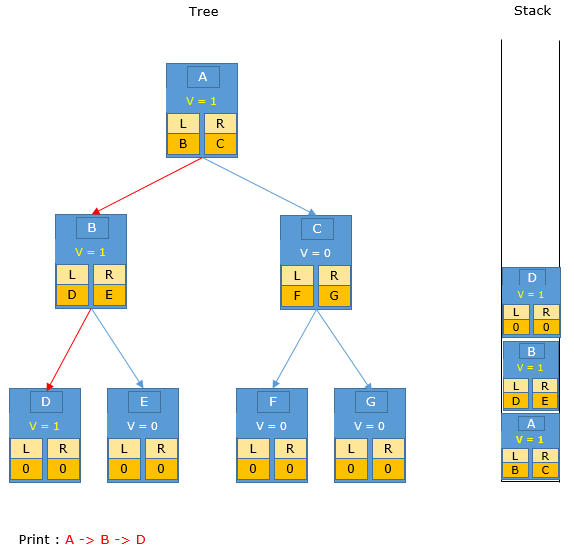
|
Get the item on the top of the stack shown in previous step (this is 'B' in this case).
Get the node on the left branch of 'B'. (it is 'D' in this case)
If it is unvisited(v = 0), mark it as visited (set v = 1), print it and put it into stack.
The result is as shown here.
|
|
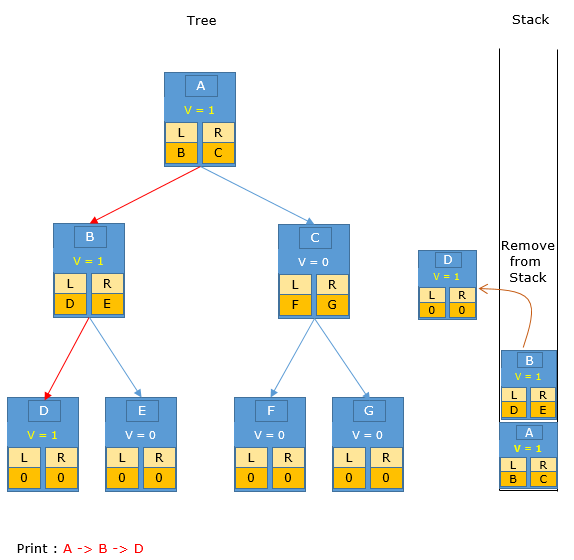
|
Get the item on the top of the stack shown in previous step (this is 'D' in this case).
Get the node on the left branch of 'D', but there is nothing on the left.
Get the node on the right branch of 'D', but there is nothing on the left.
Since there is no 'unvisted branch' on this item (D), remove it from the stack.
The result is as shown here.
Now the top item on the stack is 'B'.
|
|
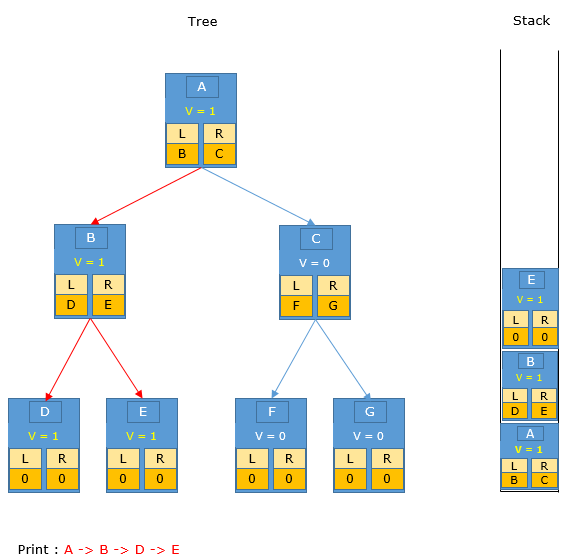
|
Get the item on the top of the stack shown in previous step (this is 'B' in this case).
Get the node on the left branch of 'B'. (it is 'D' in this case). But 'D' is marked 'visited' (v= 1). So do nothing for 'D'.
Get the node on the right branch of 'B'(It is 'E' in this case)
It is unvisited(v = 0). so mark it as visited (set v = 1), print it and put it into stack.
The result is as shown here.
|
|
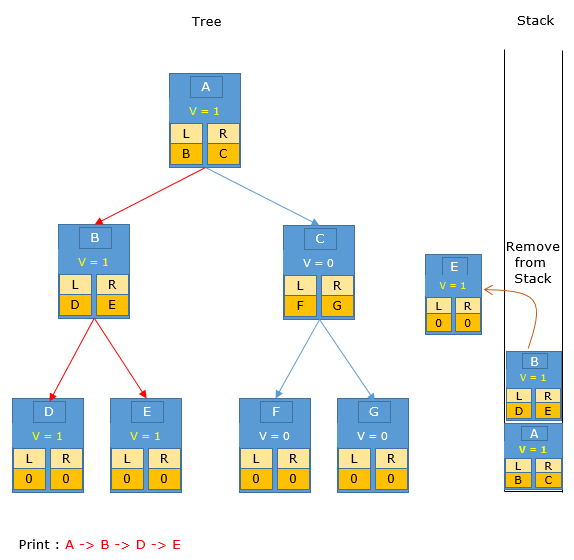
|
Get the item on the top of the stack shown in previous step (this is 'E' in this case).
Get the node on the left branch of 'E', but there is nothing on the left.
Get the node on the right branch of 'E', but there is nothing on the left.
Since there is no 'unvisted branch' on this item (E), remove it from the stack.
The result is as shown here.
Now the top item on the stack is 'B'.
|
|
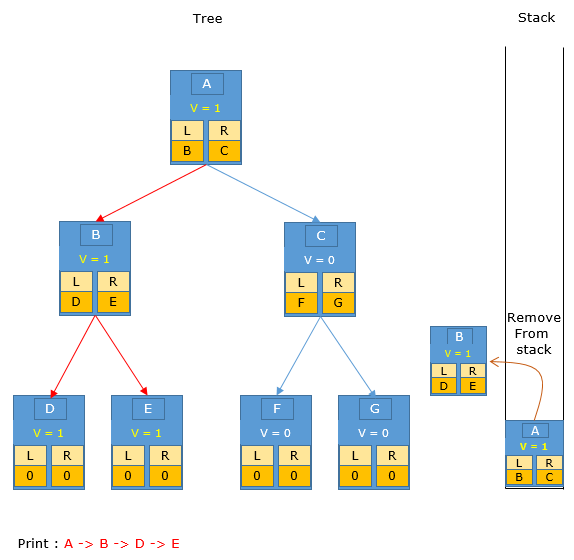
|
Get the item on the top of the stack shown in previous step (this is 'B' in this case).
Get the node on the left branch of 'B' (it is D) but D is already visited
Get the node on the left branch of 'B' (it is E) but D is already visited.
Since there is no 'unvisted branch' on this item (B), remove it from the stack.
The result is as shown here.
Now the top item on the stack is 'A'.
|
|
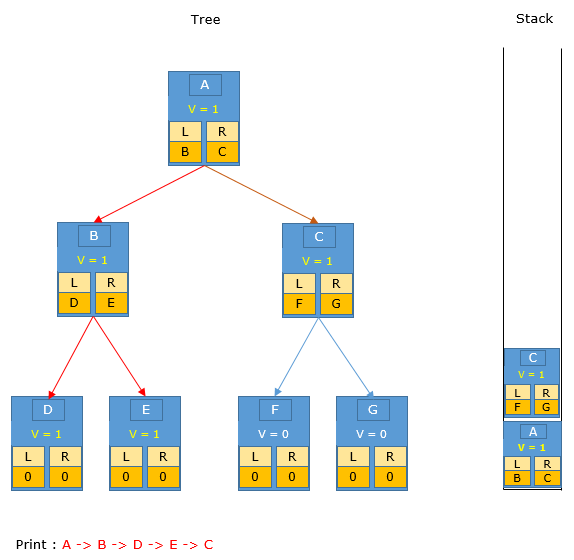
|
Get the item on the top of the stack shown in previous step (this is 'A' in this case).
Get the node on the left branch of 'A'. (it is 'B' in this case). But 'B' is marked 'visited' (v= 1). So do nothing for 'D'.
Get the node on the right branch of 'A'(It is 'C' in this case)
It is unvisited(v = 0). so mark it as visited (set v = 1), print it and put it into stack.
The result is as shown here
|
|
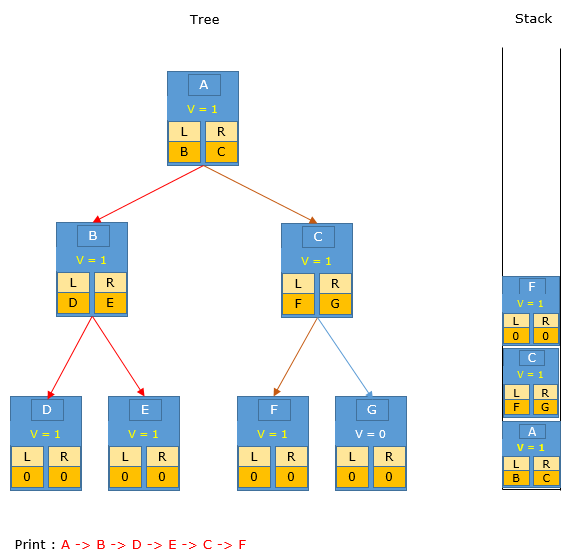
|
Get the item on the top of the stack shown in previous step (this is 'C' in this case).
Get the node on the left branch of 'C'. (it is 'F' in this case)
it is unvisited(v = 0), so mark it as visited (set v = 1), print it and put it into stack.
The result is as shown here.
|
|
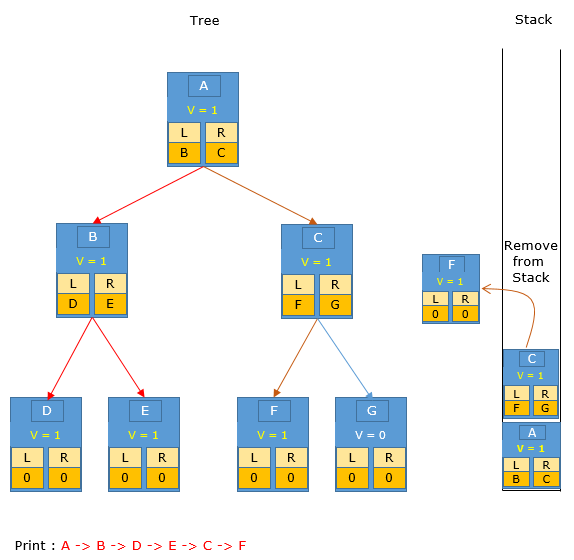
|
Get the item on the top of the stack shown in previous step (this is 'F' in this case).
Get the node on the left branch of 'F', but there is nothing on the left.
Get the node on the right branch of 'F', but there is nothing on the left.
Since there is no 'unvisted branch' on this item (F), remove it from the stack.
The result is as shown here.
Now the top item on the stack is 'C'.
|
|
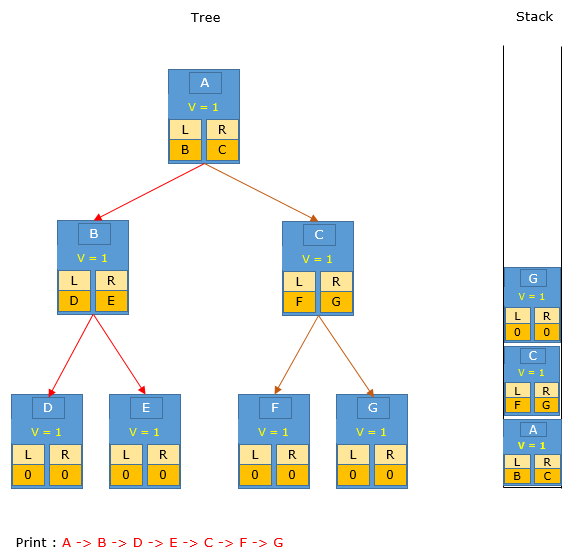
|
Get the item on the top of the stack shown in previous step (this is 'C' in this case).
Get the node on the left branch of 'C'. (it is 'F' in this case). But 'F' is marked 'visited' (v= 1). So do nothing for 'D'.
Get the node on the right branch of 'C'(It is 'G' in this case)
It is unvisited(v = 0). so mark it as visited (set v = 1), print it and put it into stack.
The result is as shown here
|
|
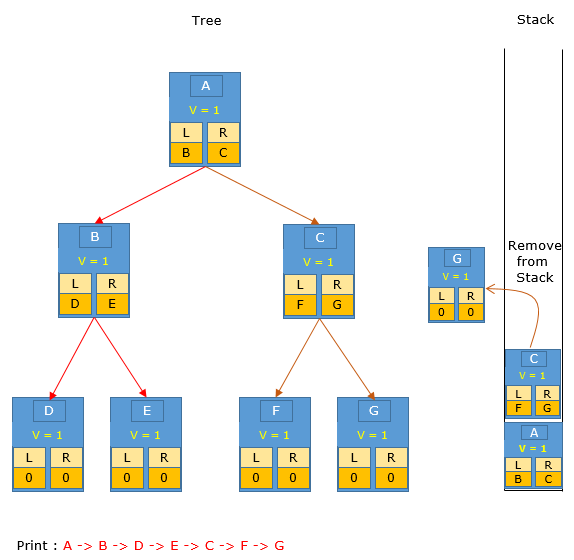
|
Get the item on the top of the stack shown in previous step (this is 'G' in this case).
Get the node on the left branch of 'G', but there is nothing on the left.
Get the node on the right branch of 'G', but there is nothing on the left.
Since there is no 'unvisted branch' on this item (G), remove it from the stack.
The result is as shown here.
Now the top item on the stack is 'C.
|
|
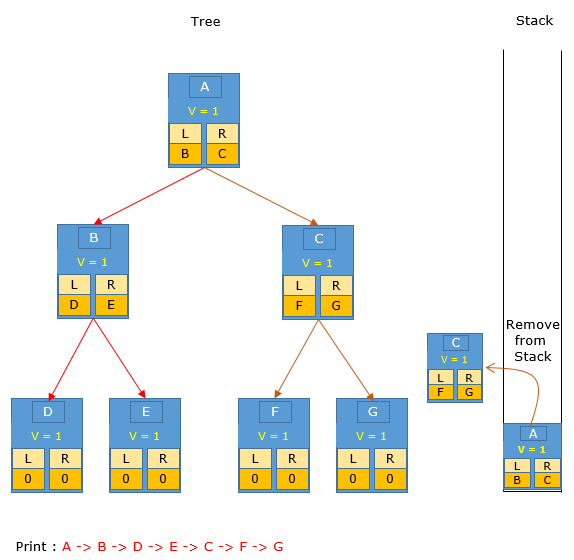
|
Get the item on the top of the stack shown in previous step (this is 'C' in this case).
Get the node on the left branch of 'C' (it is F) but F is already visited
Get the node on the left branch of 'C' (it is G) but G is already visited.
Since there is no 'unvisted branch' on this item (C), remove it from the stack.
The result is as shown here.
Now the top item on the stack is 'A'.
|
|
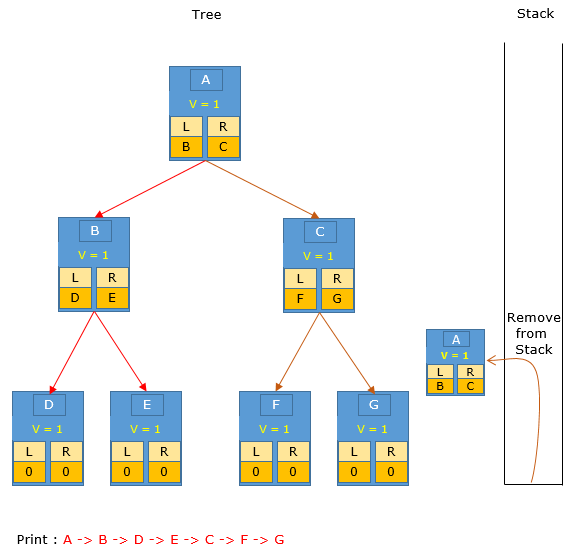
|
Get the item on the top of the stack shown in previous step (this is 'A' in this case).
Get the node on the left branch of 'A' (it is B) but B is already visited
Get the node on the left branch of 'A' (it is C) but C is already visited.
Since there is no 'unvisted branch' on this item (A), remove it from the stack.
The result is as shown here.
Now the Stack is Empty
|
|
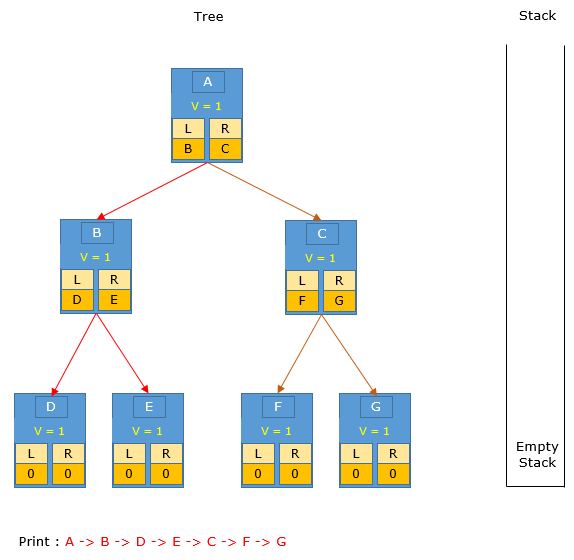
|
Process stops here since the stack is empty.
|
